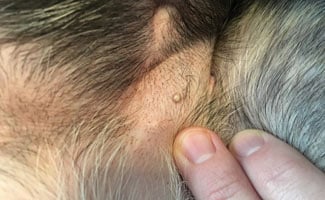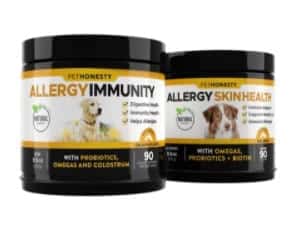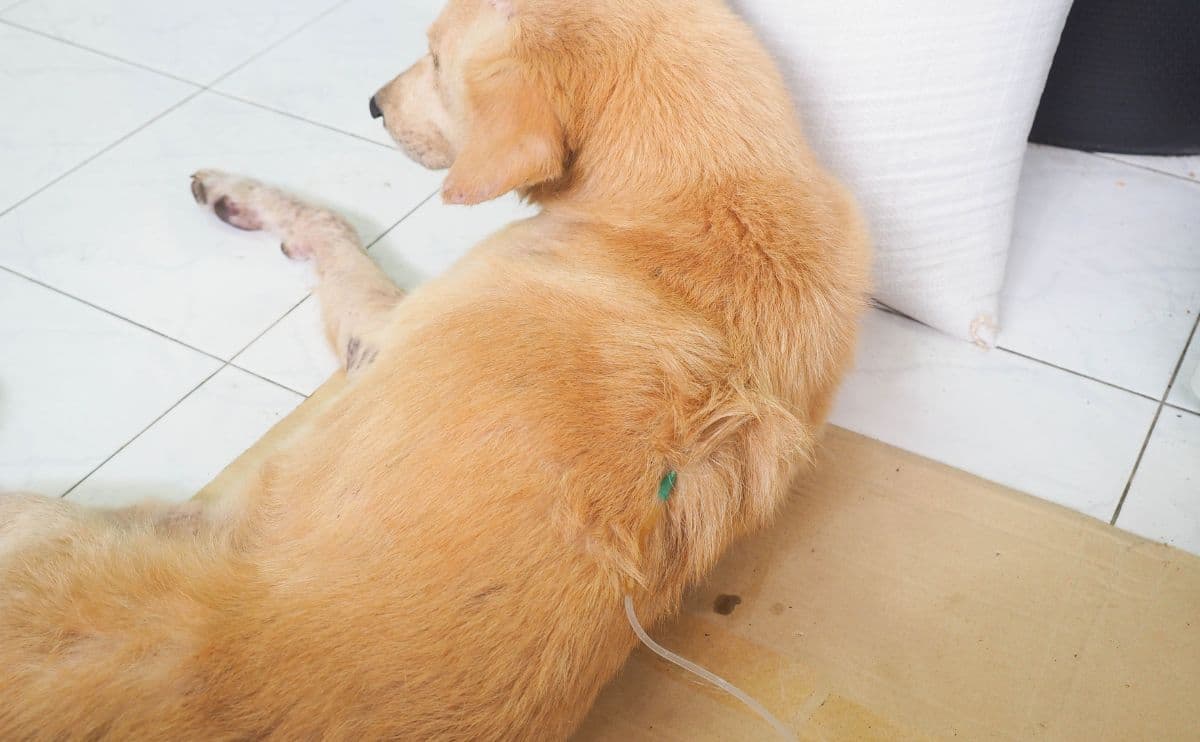This content was reviewed by veterinarian Dr. Elizabeth Racine, DVM.
When you purchase through links on our site, we may earn a commission. Here’s how it works.

If you have ever suffered from allergy symptoms, you know how miserable they can make you feel. The world is foggy, your brain is dull, your eyes and skin itch incessantly, your sinuses are like a dripping faucet, and you are tired and lethargic. Dog allergy symptoms are very similar, and they can feel miserable too.
Is My Dog Having An Allergic Reaction?
Although they can’t tell you what’s wrong, you can usually detect a problem using some simple signs.
Scratching vs Allergic Reaction
- Allergies: Scratching without relief from the itch. More frequent and intense. Often accompanied by continuous licking. Dogs with allergies are less energetic than usual – the canine version of a human’s foggy blur.
- Normal itches: Relieved with a simple scratch.

Types Of Dog Allergies
Dog allergies or sensitivities fall into five major categories, which we’ll go into more detail below.
- Environmental
- Food
- Contact
- Bacterial
- Flea
1. Environmental Allergies
The most common canine allergic condition is called atopy. Atopy or atopic dermatitis is caused by a skin barrier defect, allowing environmental allergens like dust and pollen to penetrate and incite an inflammatory response in your pet including their eyes. Because there are so many possible causes, this category is also the most difficult to diagnose. One way to minimize environmental irritants in your home is to get an air purifier.
Symptoms
- Relentless scratching
- Obsessive licking all over the body
- Patchy bald areas from all the scratching and itching
- Saliva may stain light-colored hairs, resulting in orange or reddish-brown hair
- Rubbing around the eyes, ears, armpits, groin, or inside the thighs
Treatment: Dog Allergy Testing
These same symptoms could indicate additional allergens as well. Therefore, it is best to rule out all other possible irritants first, and then, if the symptoms persist, consult your vet for allergy testing or consider an at-home dog allergy test and possible allergy medication.
2. Food Allergies
Food is a common dog allergen. Dogs are most likely to be allergic to any proteins commonly found in dog food, including dairy products or meats such as beef, chicken, pork, lamb, or fish.
Symptoms
Food allergens typically present with both gastrointestinal issues (GI) and skin irritations. If your dog is vomiting or has diarrhea, or if they are scratching incessantly, it could be an allergic reaction to something they ate. Other signs include runny stool or butt scootching from impacted annal glands.
Treatment
Although dogs can be allergic to any food, the most common allergens are chicken, beef, dairy, and egg. Your veterinarian may prescribe a diet that does not include these ingredients to see if your dog’s symptoms disappear. If the symptoms subside after approximately two months, and process of elimination, you will know that he likely suffers from a food allergy, and you can steer clear of these ingredients in the future. If the symptoms continue, speak with your vet about other possible causes or try out one of our picks for best dog food for allergies.
3. Contact Allergies
Contact allergies are reactions to something the dog has directly touched. The most common causes are topical medications, fabrics on bedding or furniture, plastic toys, food bowls, or even flea collars. Your dog could even be allergic to other pets in the family or, worse yet, you.
Symptoms
- Reddish skin
- Pimple-like protrusions that seep pus
- Hives
- Swelling of the face, ears, lips, or eyelids
- Sneezing
Treatment
Unfortunately, the only real solution to contact allergies is to remove the culprit from the dog’s environment altogether. The good news, however, is that contact allergies are the least common of all dog allergies.
4. Bacterial Hypersensitivity
All dogs have some Staph bacteria on them. This is normal. What isn’t normal is when, on occasion, a dog develops a hypersensitivity to the bacteria. When this happens, your dog will suffer hair loss. These patches can become raw from scratching, and then they become infected.
Symptoms

- Pimple-like pustules
- Dry patches of flaking skin
- Itching
- Hair loss
- Odor
Treatment
One way to treat bacterial allergies is with antibiotics but some vets may also include an additional treatment of Staph Lysate.
First-Hand Experience: Allergies Can Cause Staph Infection
Kimberly, a writer for Canine Journal, took her dog, Sally, to the vet after noticing her scratching and licking excessively. This is her experience below.
“Sally had been licking and scratching a lot, and her belly and armpit areas were red. We applied some cortisone, which helped reduce the redness, but it never completely resolved itself. Allergies weren’t on our minds at all since it was winter. In fact, we thought she was suffering from extremely dry skin because it was a particularly brutal winter.
We decided Sally needed to see a vet since it wasn’t getting better. The vet took one look at her and knew it was allergies within seconds. The vet said it was most likely some type of indoor allergen since Sally spent most of the winter inside, where it was warm.
Sally had irritated the area enough for her also to develop a Staph infection. I asked the vet how she knew Sally had a Staph infection. She said the pus-filled lesion and her dry, flakey skin were tell-tale signs.
I felt a lot of guilt for not getting Sally into the vet sooner, but I was also glad she was getting the care she needed. The vet prescribed Cephalexin (an antibiotic) and Prednisone (a steroid) to alleviate the allergies and get rid of the Staph infection. The vet also told me that this was the most common illness she sees during the winter.”
– Kimberly A., Canine Journal
5. Flea Allergies
Fleas are a significant problem. If your dog has fleas, your home will soon be infested as well. So whether or not your dog is allergic to fleas, you will undoubtedly want to eliminate them. The flea is not the actual allergen. It’s the flea’s saliva that causes terrible discomfort for your dog.
Symptoms
These symptoms are common on the back half of the dog, but they can appear anywhere on the body.
- Persistent scratching (especially around the tail)
- Loss of hair
- Scabs on the skin
Treatment
The best way to beat an allergic reaction to fleas is to get rid of the fleas and then take preventative measures to ensure the fleas never come back. Medications and flea collars are best for this purpose.
Allergies Are A Common Skin Problem
If your dog is scratching more than usual, start paying close attention to the triggers listed above. Allergies are just one possible skin condition. The symptoms all look alike. If you suspect your dog may be suffering, visit your vet at the first signs to get an appropriate diagnosis– don’t wait until the problem gets worse.
You can also order an at-home allergy test to determine possible irritants.
If you cannot figure it out on your own, however, you should consult your vet for a skin test that will tell you for sure what your dog needs to avoid to be healthy, comfortable, and happy. Skin problems, including allergies, are among the most common illnesses for dogs. Find out what other common skin issues dogs have so you know what to watch for.
Allergy Treatment Options

If your dog suffers from digestive health issues or excessive scratching, you might want to consider adding in a shampoo, chew, or food topper to their daily regimen. PetHonesty has various options, including allergy immunity chews, itch relief shampoo, and anti-scratch salmon oil. PetHonesty’s facility is Good Manufacturing Practices certified with a Level 3 Safe Quality Food certification. As always, double-check with your vet before starting a supplement and monitor symptoms and behaviors before and after treatment. If severe enough, your vet may recommend allergy shots for your dog. Learn more in our PetHonesty reviews.
Pet Insurance May Help Pay Vet Bills
Chronic health concerns and dog allergic reactions can lead to lots of vet visits and bills. In other words, your dog’s allergies could turn into a very expensive problem. But, if you have pet insurance before your dog is diagnosed with the issue and are still active with that policy, there is a good chance that your carrier will at least partially cover the vet bills.
Now would be an excellent time to take a look at your policy and give your pet insurance company a call to see if they can help you make an already irritating ailment a little less financially painful by covering for allergy shots and testing. Or, if you have a new puppy and are worried it may have chronic allergies in the future, be sure to signup for a reliable pet insurance policy before the condition is considered a pre-existing condition.
Tagged With: Allergies, Reviewed By Dr. Racine, DVM

